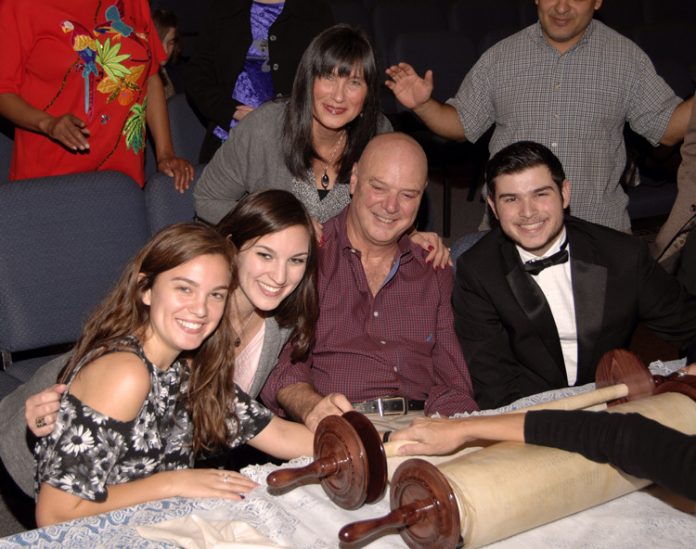
Shown with the Holocaust Torah (front row, L-R) Sophia Charyton, Melanie Charyton, Hector Charyton, and Thomas Charyton. Back, Claudia Charyton. Photo/Special.
When Congregation B’nai Israel began a fund raiser in January and invited congregants to “tie one on,” congregants were perplexed. What exactly did the synagogue expect them to do? While the expression “tie one on” usually connotes visions of imbibing alcohol, at CBI it meant something totally different, something respectful and essential.
Congregation Bnai Israel, located in eastern Fayetteville, is charged with the care and use of a Holocaust Torah, one of the 1,564 Torah scrolls that were rescued during the war. This care requires that the Torah scroll be rolled from one end to the other twice a year and read from on several occasions.
This past summer, during one of these carefully orchestrated roll outs, something went askew. Susan Burden, CBI’s cantorial soloist explains, one top of the roller, Aytz Chayim, that attaches to the holy Scroll, rolled off and down the bema and then down the stairs. The rollers, which had been attached in the 1990s, needed to be replaced and the Torah scroll honored with replacement Aytz Chayim.
“Tie one on” meant carefully and respectfully sewing on new rollers.
CBI purchased beautiful new rollers and began fund raising for the cost.
CBI members outdid themselves. Within weeks $10,000 was raised by the small congregation of 60 families.
There was a perk. Donations would allow the donors a once in a lifetime opportunity to stitch the Torah scroll to the Aytz Chayim. Needed: 12 stitchers.
On Saturday, Feb. 11, following a Havdalah service, congregants, some with spouses and family, walked up the bema to add the required stitch. One donor offered the opportunity for the recent Bnai Mitzvah children to participate. All six showed up to do stitches.
One donor paid more than $4,000 to do the first stitch.
Burden explained the importance of the event to those present and shared instructions on how to do the attachment.
Special scissors and kosher sinew thread were required. Gold plated scissors were purchased since no metal that can be used for weapons is allowed to touch the Torah. Each stitch was done carefully. Some held their breath and others worked with shaking hands. Those present recalled that it was an incredible experience and they felt they were a part of the history of the Holocaust Torah.
Some attendees were amazed that ordinary Jewish people were allowed to perform the attachment.
CBI’s Holocaust Torah hails from a small town, Sobeslav, in what is now the Czech Republic. Jews settled there in the 16th century and were ousted in 1606 and moved to neighboring towns.
In 1848 Jews were again allowed to reside in the village. They were a small but thriving community with a synagogue that housed two Torahs.
In November 1942, all Jews were deported to Theresienstadt concentration camp and from there to Auschwitz to be murdered. Survivors of the Holocaust in Sobeslav — two Torahs and two residents. One of these Torahs is on permanent loan to Congregation Bnai Israel and the other resides in Temple Beth Shalom in Needham, Mass.
The synagogue in Sobeslav was used after the war for storage until it was torn down in 1959.
(Some information from Shumacher, Florence. “TBS Holocaust Torah.” Temple Beth Shalom, Nov 2015.)





